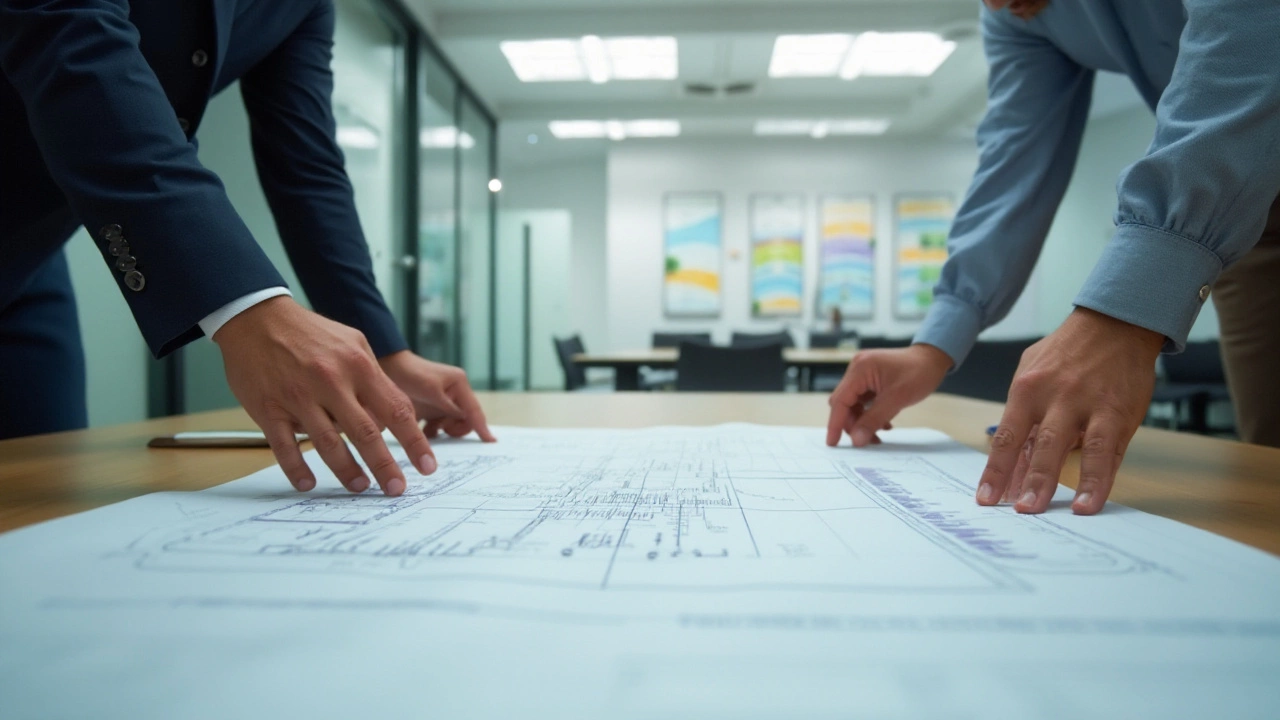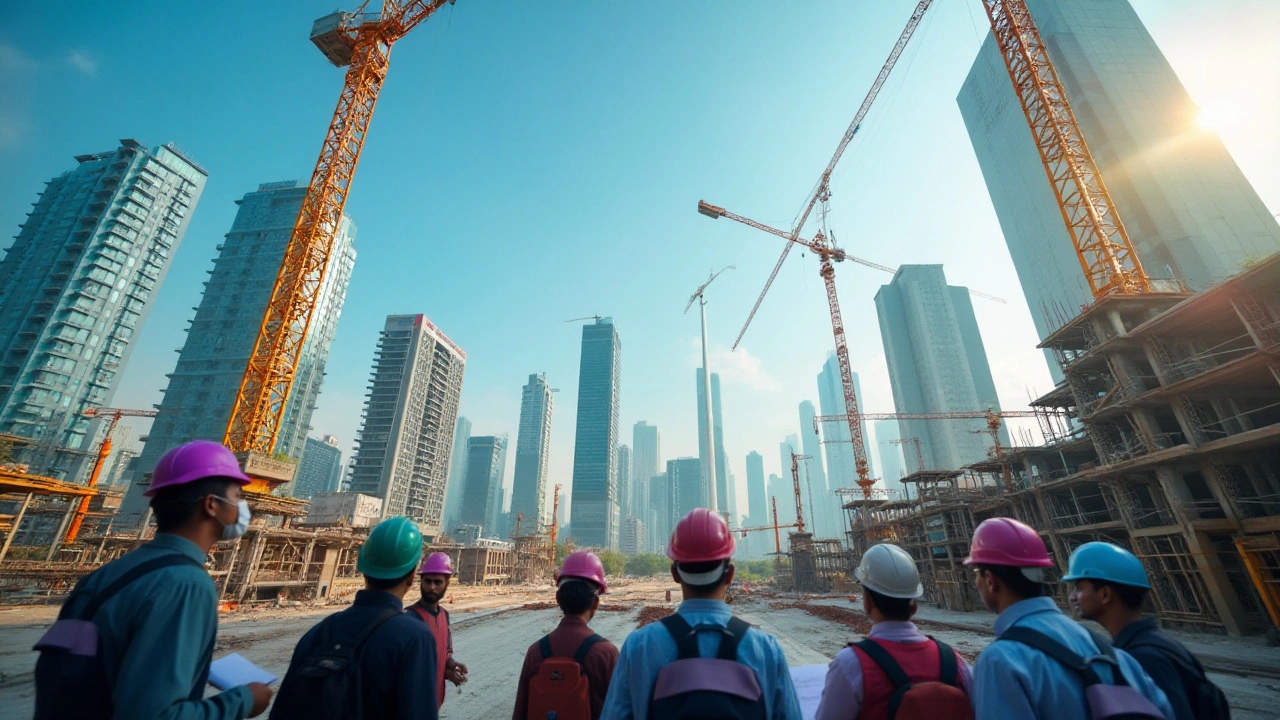When you dive into the bustling world of construction, you might hear the term 'commercial construction' thrown around quite a bit. But what exactly does it mean at a federal level? To put it simply, commercial construction covers any structure designed to generate profit or serve a business purpose, rather than for private residential use.
This broad definition shapes every facet of commercial projects, dictating the rules, regulations, and standards builders and contractors must follow. If you're embarking on such a project, you'll find that understanding these definitions is not just helpful—it's crucial. It serves as a foundation for compliance with building codes, safety protocols, and even environmental impacts.
Peeling back the layers of federal regulations reveals a fascinating insight into how these rules impact planning and execution in the construction sphere. Whether you're a seasoned professional or new to the field, getting a firm grasp of these concepts is indispensable for success.
- Defining Commercial Construction at the Federal Level
- Differentiating Between Commercial and Residential Construction
- Regulations Governing Commercial Construction
- Key Aspects of Federal Building Codes and Safety Standards
- Environmental Considerations in Commercial Construction
- Tips for Navigating Federal Regulations in Construction Projects
Defining Commercial Construction at the Federal Level
Understanding the federal definition of commercial construction requires delving into the distinctions drawn by lawmakers and industry standards. At its core, commercial construction encompasses projects where the end goal is profit or fulfilling a business function. Unlike residential dwellings intended for personal habitation, commercial buildings include a range of spaces such as office buildings, manufacturing facilities, warehouses, retail centers, and restaurants. What sets commercial apart from residential, in a broad sense, is the scale, complexity, and the purpose these structures serve. These projects are often larger, require specific designs to accommodate specialized needs, and adhere to more stringent regulations. Think of skyscrapers towering in urban landscapes or burgeoning industrial estates—these are quintessential examples.
At the federal level, defining commercial construction involves various agencies such as OSHA, with safety protocols, and the Environmental Protection Agency (EPA), focusing on sustainable practices. The federal government employs building codes and standards that vary depending on the nature of the project. For instance, the Americans with Disabilities Act (ADA) mandates accessibility features in commercial structures. This attention to function dictates many design and construction elements and inevitably influences the materials used, right down to the style of windows chosen.
To emphasize how important safety is, let's look at OSHA's role in providing guidelines. Their standards ensure that these projects meet requirements that protect both the workers and future occupants. The interplay between state and federal regulations can’t be overlooked either, as both levels often collaborate, making it essential to stay informed on what applies where you build. According to a 2022 report by the National Association of Home Builders, commercial construction spending in the U.S. continues to climb, underscoring the expanding scope of what falls under this federal definition.
The realm of commercial construction is diverse and increasingly incorporates innovations in sustainability and technology. Builders are now expected to create energy-efficient designs that reduce environmental impact, potentially qualifying for certifications like LEED. This shift towards more ecologically responsible practices reflects a growing trend where federal definitions are adapting through legislation and standards to foster these initiatives. As structural heights increase and techniques evolve, remaining compliant with federal standards ensures not only project success but also long-term sustainability.
With the industry's complexity, businesses must focus on these federal definitions to avoid pitfalls that could lead to costly project delays. Incorporating best practices in compliance during planning and execution can mean the difference between a smooth operation and one fraught with regulatory headaches. In the words of a seasoned builder, "Navigating the vast terrain of federal requirements can seem daunting, but it’s the bedrock of responsible construction." Staying informed is key, and with each project, there's always a new lesson to learn regarding how federal definitions impact commercial construction's landscape.
Differentiating Between Commercial and Residential Construction
When stepping into the realm of construction, one of the fundamental distinctions is between commercial construction and residential builds. Understanding the differences is pivotal for any professional in the industry, as it influences everything from initial planning to the final touches. At its core, the principal distinction lies in the purpose and use of the building. While residential construction typically involves structures like houses and apartment complexes meant for living, commercial projects are designed for business purposes such as offices, retail spaces, and manufacturing facilities.
Commercial construction projects are usually larger in scale and more complex than their residential counterparts. This complexity often arises from the need to accommodate larger spaces, intricate designs, and specialized equipment. For example, a shopping mall typically requires a multitude of electrical and plumbing systems to support various stores and amenities, something quite different from a single-family home. In contrast, residential construction generally prioritizes personal comfort and aesthetic appeal over industrial function.
A critical factor distinguishing these construction types is the applicable laws and regulations. Federal, state, and local building codes differ significantly for commercial projects as opposed to residential ones. Commercial buildings often face stricter zoning laws and safety regulations. This is because these structures host larger groups of people and must adhere to rigorous standards to ensure public safety. Concepts such as handicap accessibility, fire safety systems, and environmental impact assessments are paramount in commercial endeavors.
Moreover, the financing and budgeting for commercial and residential constructions differ markedly. Commercial projects usually demand more significant capital outlay and can take years to complete, necessitating comprehensive financial planning and risk management strategies. Investors and companies involved in these large-scale projects must meticulously scrutinize every financial aspect to ensure profitability and sustainability. On the contrary, residential construction often sees funding through personal mortgages or small bank loans, with a more personal financial investment.
Another exciting area of difference is the stakeholder involvement in the construction process. Commercial construction projects engage a wide range of stakeholders, from architects and engineers to government officials and business owners. Their collaboration is essential to ensure that designs meet business needs and compliance requirements. In contrast, residential buildings primarily revolve around homeowners, designers, and contractors, focusing more on personal preferences and individual client satisfaction.
Commercial construction projects emphasize adaptability to evolving technological trends and sustainability practices. With the rise of smart buildings and eco-friendly materials, commercial construction is continuously innovating to integrate green technologies and boost energy efficiency. This contrasts with the traditional focus seen in many residential projects, which prioritize homely comfort and personal space optimization. As American architect Frank Gehry once said,
"Architecture should speak of its time and place, but yearn for timelessness."In a commercial setting, achieving that balance often requires innovative design and cutting-edge technology.

Regulations Governing Commercial Construction
Diving headfirst into the ocean of commercial construction requires a firm understanding of the various regulations that govern it. These regulations ensure that buildings are safe, sustainable, and suitable for public use. One of the key factors is adherence to local, state, and federal building codes, each of which has its own unique set of requirements. These codes encompass everything from the structural integrity of a building to its environmental impact. It's a lot to digest, but getting familiar with these details can mean the difference between a smooth project and a tangled mess of red tape.
Here in New Zealand, we know that the journey from blueprint to building is peppered with checks and balances. For example, federal regulations often include guidelines related to the Americans with Disabilities Act (ADA) to ensure accessibility. Similar compliance is echoed in the Building Code of Australia, which has its own criteria on disability access. Builders and developers need to be particularly mindful of these rules as failing to meet them doesn't just slow down the project; it can halt it altogether.
"Navigating construction regulations can seem daunting, but they are there for a reason—safety is paramount," assures an expert from Building Connections Monthly.
Within the scope of federal guidelines, there are also rigorous safety standards addressing the confines of workplace safety under the Occupational Safety and Health Administration (OSHA). OSHA mandates cover everything from the working conditions of the construction site to what protective gear workers must wear. It's not unusual for these regulations to change, too, responding flexibly to new technologies and methods in construction. Keeping up with these changes can spare a lot of headaches down the line.
Energy efficiency and sustainability are also integral to today's construction regulations. Governments worldwide are making a concerted effort to reduce the carbon footprints of new buildings. The U.S.'s Leadership in Energy and Environmental Design (LEED) and the UK's BREEAM provide frameworks to incentivize energy-saving designs. Adhering to them isn't always mandatory, but projects that do can benefit from tax incentives or other financial perks. The mantra of 'building green' is becoming ever more potent in the realm of commercial construction.
Navigating Complex Compliance
Understanding regulations is just the start; applying them correctly is where expertise truly comes in. This process demands coordination between architects, contractors, and legal advisors. Proper documentation, timely permit filings, and addressing zoning laws all form part of the puzzle. It often pays to have someone onboard who specializes in regulatory compliance to forewarn of potential snags. Mishaps can prove costly, especially if fines or project delays are involved. Any savvy developer knows that such due diligence is non-negotiable.
Here's where it gets technical but practical—a recent study found that projects integrating regulatory oversight from the beginning had a 25% higher success rate. Projects aligned with ever-evolving building regulations are more likely to be completed on time and within budget. At the end of the day, understanding and aligning with these regulations isn't just about legal compliance. It's an investment in the future of the business and its community footprint, paving the way for sustainable development.
Key Aspects of Federal Building Codes and Safety Standards
When tackling a commercial construction project, adhering to federal building codes and safety standards should stand as a primary consideration. These guidelines aren't merely bureaucratic red tape; they are the backbone of ensuring robust, secure, and efficient structures are brought to life. The federal layers of these codes set the baseline for safety and structural integrity across the entire country, acting as a protective measure against hazards and mishaps.
Each standard holds particular nuances but all tie back to the ultimate goal of safeguarding lives and maintaining orderly conduct in the construction industry. From ensuring electrical wiring is properly insulated to meeting stringent fire safety standards, these building codes encompass a variety of elements that unify under the umbrella of safety and compliance. Additionally, building codes have environmental and operational guidelines which influence energy consumption and sustainability in new constructions.
Codes like the International Building Code (IBC), which defines structural standards for buildings across many U.S. regions, illustrate the depth and breadth these regulations cover. The Occupational Safety and Health Administration (OSHA), likewise, outlines procedures for workplace safety that protect workers and diminish the risks of on-site accidents. OSHA's standards frequently adjust to incorporate modern safety research, ensuring projects remain aligned with new safety insights.
According to the National Institute of Building Sciences, "Adopting building codes has saved the U.S. nearly $16 billion annually in prevented damage from adverse weather environments."
Understanding building codes in line with the specified location of construction is crucial. Certain states may have additional requirements or more restrictive guidelines than federal mandates. Regular training and consultation with safety experts and code inspectors can not only minimize regulatory hiccups but ensure a smoother operation from commencement to completion.
Moreover, with the inevitable shift towards smart and environmentally friendly buildings, keeping pace with updates in building codes remains imperative. Regulatory bodies regularly implement new standards that reflect technological advancements and environmental aspirations. Staying informed means embedding the latest innovations and safety measures into your projects, ensuring they are not only safe but future-proof.
For those invested in commercial projects, understanding and maintaining these federal codes is not just an obligation—it's a professional commitment. A commitment to the wellbeing of your workforce, the integrity of your completed structures, and the longevity and safety of those who will eventually use them. In enhancing your knowledge and preparedness, you ensure your projects rise to every challenge and meet the highest standards of tomorrow.

Environmental Considerations in Commercial Construction
In the modern era, embedding sustainability into commercial construction is not just desirable; it’s essential. From urban planners to developers, everyone is acknowledging the need for environmentally conscious decisions during construction processes. Regulation changes at federal levels are increasingly spotlighting the importance of eco-friendly practices—a shift that not only helps in reducing the environmental footprint but also boosts project viability in the long run.
One of the foremost elements in making construction eco-friendly is the adoption of sustainable materials. Using recycled steel, bamboo, and other renewable products significantly cuts down on waste and resource depletion. For instance, when you choose recycled steel, you save approximately 75% of the energy it would otherwise take to produce new steel. Similarly, bamboo grows rapidly compared to traditional timber, offering a sustainable alternative without compromising structural integrity.
Energy efficiency remains another cornerstone in this endeavor. Modern commercial buildings are increasingly designed to be energy self-sufficient. Techniques such as solar panel installations, smart windows that regulate indoor temperature, and advanced insulation materials are becoming the norm rather than the exception. An energy-efficient building not only conserves resources but also passes the test of federal standards which are anticipated to become more stringent with each passing year.
Water conservation also holds strong sway in environmentally-friendly projects. Implementing rainwater harvesting systems, low-flow plumbing fixtures, and greywater recycling systems can drastically reduce water usage. This is crucial as many regions face the impending threat of water scarcity. Water-efficient practices do not just fulfill regulatory requirements but also offer significant cost savings over time, especially for large commercial setups.
An often overlooked but impactful aspect is reducing construction and demolition waste. Techniques such as precise planning, modular construction, and effective recycling programs can minimize waste significantly. Federal guidelines often aim to decrease waste by promoting the reuse and recycling of materials whenever feasible. Construction projects that aim to be truly sustainable tend to adopt a circular economy approach where materials find a second life rather than ending up in landfills.
"The greenest building is one that is already built," emphasizes Carl Elefante, an architect known for his advocacy in sustainable architecture.
The landscape of commercial construction has also seen a notable shift towards enhancing biodiversity within projects. Incorporating green roofs, living walls, and urban gardens are these burgeoning trends intended to harmonize urban structures with nature. Research shows that such implementations do more than just beautify spaces—they improve air quality, reduce urban heat, and provide habitats for local wildlife.
Taking these eco-conscious steps demands an in-depth understanding of regulations and best practices, coupled with a commitment to innovation. As sustainability hurdles evolve, businesses that align their construction strategies with environmentally sound principles stand to gain more than just regulatory compliance—they earn the planet's and the community’s nod of approval.
Tips for Navigating Federal Regulations in Construction Projects
Embarking on a commercial construction venture can feel like setting sail in uncharted waters, particularly when faced with a sea of federal regulations. These rules, while complex, serve an essential purpose in ensuring safety, compliance, and quality throughout the construction process. To successfully navigate these waters, builders, contractors, and developers must equip themselves with a solid strategy and a detailed understanding of the requirements. A key step is to begin with comprehensive research, familiarizing oneself with the specific regulations pertinent to the project's location and type. Federal guidelines often overlap with state and local laws, each layer adding its own set of requirements and nuances. Gathering information at the outset can prevent costly mistakes and delays down the line.
Building codes and safety standards are fundamental aspects regulated at the federal level. Understanding these can significantly impact a project's trajectory. One useful tip is engaging with compliance experts or consultants who specialize in construction regulations. Their expertise can be invaluable in deciphering complex legal language and anticipating potential issues. Additionally, maintaining an organized documentation process throughout the project's lifespan is crucial. Not only does this streamline compliance checks, but it also serves as a defense in the face of unforeseen challenges or audits.
"Navigating the intricate landscape of construction regulations often requires both diligence and patience. The right approach can transform complexity into a seamless operation," says John Chamberlain, a renowned expert in construction law.
Another practical approach is leveraging technology to stay compliant. Modern construction management software offers tools for tracking compliance tasks, documenting progress, and ensuring all team members are aligned with the current regulations. This digital transformation not only boosts efficiency but also helps in catching potential non-compliance issues early on. Networking can also play a pivotal role in easing the navigation of federal regulations. Connecting with other professionals in the commercial construction industry can provide fresh insights and innovative solutions for overcoming regulatory hurdles.
Continued education is equally important. Regulatory environments evolve, and staying updated through workshops, seminars, and courses can fortify a construction team's knowledge base. Encourage team members to pursue certification programs aimed at enhancing their understanding of federal regulations and their applications. This investment in knowledge often pays dividends in the form of smoother project execution and enhanced project quality. Ultimately, a proactive, informed approach can make federal regulations less of a daunting obstacle and more of a guide to building excellence.
In summary, navigating federal regulations requires a blend of research, expert consultation, technological integration, networking, and continued education. By prioritizing these strategies, those involved in construction projects can not only achieve compliance but also gain a competitive edge in the ever-evolving construction landscape.

Written by Fletcher Abernathy
View all posts by: Fletcher Abernathy